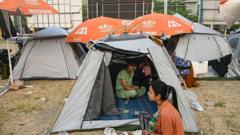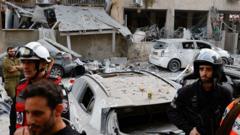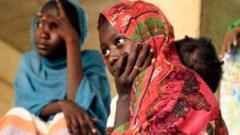In the wake of a powerful earthquake, the military's manipulation of aid raises alarms about intentions and accessibility.
Myanmar's Humanitarian Crisis: Aid or Warfare?

Myanmar's Humanitarian Crisis: Aid or Warfare?
The aftermath of Myanmar's earthquake reveals a disturbing pattern of military interference in humanitarian efforts.
In the immediate hours following a devastating 7.7 magnitude earthquake that struck Myanmar, the search and rescue operations vital for saving lives were severely hampered. Military authorities blocked access to some of the worst-hit regions despite a rare public call for international aid from junta chief Min Aung Hlaing. Aid groups highlighted that during the critical first 72 hours post-disaster, where survival chances significantly diminish, military-imposed restrictions and checkpoints severely limited the efforts of rescue workers.
“I’ve heard from rescuers in affected regions that they faced curfews and long waits at checkpoints with extensive questioning,” John Quinley from Fortify Rights told BBC News. Despite the junta's claims that these measures were for safety, many human rights advocates questioned the legitimacy of such restrictions, arguing that they obstruct crucial life-saving assistance.
As the disaster unfolded, the situation worsened. An aid convoy organized by the Chinese Red Cross was attacked by the military while en route to Mandalay, raising immediate concerns for the safety and viability of aid operations. While the military stated they fired warning shots when the convoy did not stop, the incident showcased a growing trend in Myanmar, where the junta has been known to selectively allow and obstruct humanitarian assistance based on its political motivations.
With deep roots in a civil war that erupted following their seizure of control in 2021, the junta is accused of weaponizing aid; it flows to territories they control while being restricted in areas with strong resistance support. Mr Quinley illustrated that the junta exploits relief efforts to deny assistance to communities where they fear losing influence.
The Office of the UN's High Commissioner for Human Rights warned that the junta often punishes the local populace by depriving them of necessary assistance, particularly in areas that show opposition to military control and governance. Recent reports indicate that as part of this strategy, parts of central Myanmar, including Sagaing and Mandalay, may suffer further restrictions on aid.
Civil society organizations have echoed this concern, urging international bodies to ensure that aid reaches those who need it most, instead of falling under military surveillance or control. A statement from 265 advocacy groups underscored that aid should not be channeled through the junta, which has a history of pushing relief sources towards its favored areas.
As it stands, citizens in Myanmar are left grappling with acute shortages of food, water, and basic supplies. Grassroots volunteers are struggling to meet the escalating needs of displaced residents, many of whom find themselves homeless and living in dire conditions. Ongoing bureaucratic obstacles introduced by the junta complicate logistics further, as any relief efforts now hinge on excessive paperwork and permissions that could delay assistance significantly.
Despite these systemic barriers, some aid agencies remain cautiously optimistic that the international response to the earthquake will prompt the junta to grant unimpeded access. As Louise Gorton from UNICEF pointed out, the scale of the crisis could pressure military leaders to facilitate relief efforts.
However, skepticism prevails. Early indications suggest a potential repeat of manipulation, as military jets conducted airstrikes in the same regions already rocked by the earthquake, asserting their intent to continue military operations. While Min Aung Hlaing temporarily accepted a ceasefire to assist relief, the overarching distrust around his actions remains.
For many observers, the junta's actions reinforce the perception of a government deftly wielding humanitarian assistance as a weapon against dissent. With fears of aid being redirected or withheld, it’s crucial for organizations and allies to track the flow of relief efforts closely. As Quinley stated, it is imperative to critically assess whether assistance actually reaches vulnerable populations or falls into the hands of those who seek to control its distribution.
“I’ve heard from rescuers in affected regions that they faced curfews and long waits at checkpoints with extensive questioning,” John Quinley from Fortify Rights told BBC News. Despite the junta's claims that these measures were for safety, many human rights advocates questioned the legitimacy of such restrictions, arguing that they obstruct crucial life-saving assistance.
As the disaster unfolded, the situation worsened. An aid convoy organized by the Chinese Red Cross was attacked by the military while en route to Mandalay, raising immediate concerns for the safety and viability of aid operations. While the military stated they fired warning shots when the convoy did not stop, the incident showcased a growing trend in Myanmar, where the junta has been known to selectively allow and obstruct humanitarian assistance based on its political motivations.
With deep roots in a civil war that erupted following their seizure of control in 2021, the junta is accused of weaponizing aid; it flows to territories they control while being restricted in areas with strong resistance support. Mr Quinley illustrated that the junta exploits relief efforts to deny assistance to communities where they fear losing influence.
The Office of the UN's High Commissioner for Human Rights warned that the junta often punishes the local populace by depriving them of necessary assistance, particularly in areas that show opposition to military control and governance. Recent reports indicate that as part of this strategy, parts of central Myanmar, including Sagaing and Mandalay, may suffer further restrictions on aid.
Civil society organizations have echoed this concern, urging international bodies to ensure that aid reaches those who need it most, instead of falling under military surveillance or control. A statement from 265 advocacy groups underscored that aid should not be channeled through the junta, which has a history of pushing relief sources towards its favored areas.
As it stands, citizens in Myanmar are left grappling with acute shortages of food, water, and basic supplies. Grassroots volunteers are struggling to meet the escalating needs of displaced residents, many of whom find themselves homeless and living in dire conditions. Ongoing bureaucratic obstacles introduced by the junta complicate logistics further, as any relief efforts now hinge on excessive paperwork and permissions that could delay assistance significantly.
Despite these systemic barriers, some aid agencies remain cautiously optimistic that the international response to the earthquake will prompt the junta to grant unimpeded access. As Louise Gorton from UNICEF pointed out, the scale of the crisis could pressure military leaders to facilitate relief efforts.
However, skepticism prevails. Early indications suggest a potential repeat of manipulation, as military jets conducted airstrikes in the same regions already rocked by the earthquake, asserting their intent to continue military operations. While Min Aung Hlaing temporarily accepted a ceasefire to assist relief, the overarching distrust around his actions remains.
For many observers, the junta's actions reinforce the perception of a government deftly wielding humanitarian assistance as a weapon against dissent. With fears of aid being redirected or withheld, it’s crucial for organizations and allies to track the flow of relief efforts closely. As Quinley stated, it is imperative to critically assess whether assistance actually reaches vulnerable populations or falls into the hands of those who seek to control its distribution.























